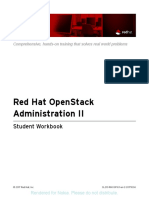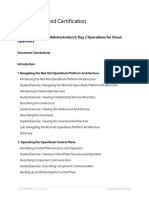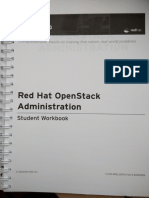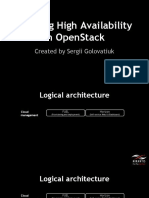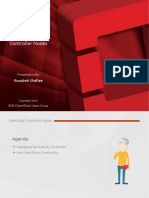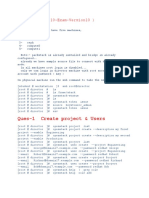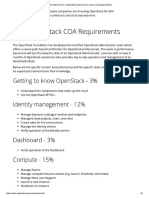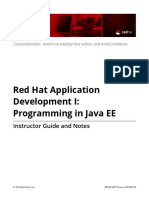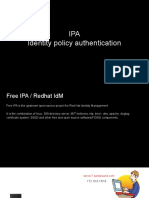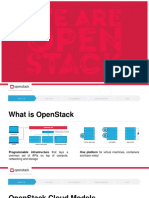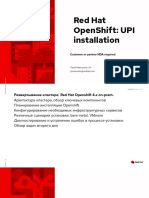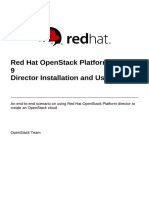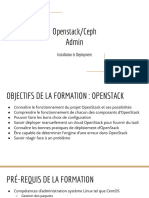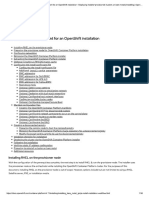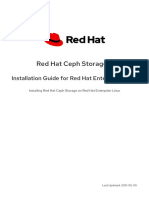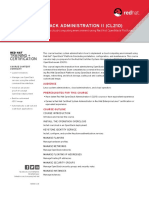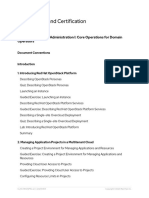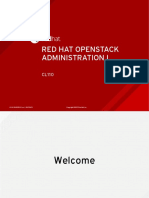50%(2)50% found this document useful (2 votes)
764 views249 pagesOpen Stack Redhat
Redhat Open Stack course
Uploaded by
Zied BannourCopyright
© © All Rights Reserved
We take content rights seriously. If you suspect this is your content, claim it here.
Available Formats
Download as PDF or read online on Scribd
50%(2)50% found this document useful (2 votes)
764 views249 pagesOpen Stack Redhat
Redhat Open Stack course
Uploaded by
Zied BannourCopyright
© © All Rights Reserved
We take content rights seriously. If you suspect this is your content, claim it here.
Available Formats
Download as PDF or read online on Scribd
You are on page 1/ 249
Me REDHAT?
— BCI te
i
4
a
4
i
E
a
; : Red Hat OpenStack
- , Administration
\
=—= Student Workbook
= a
= a
= _
_
oF
=
“ .
‘ _ E © 2014 Red Hat, nc CL210-RHELOSPS.o-en-2-20140026
» Ab WW Ah WW lb lh aol) ol li ld a lt ) } di LY
RED HAT
OPENSTACK
ADMINISTRATION
'
Lato
Red Hat Enterprise Linux OpenStack Platform 5.0 CL210
Red Hat OpenStack Administration
Edition 2
Authors: Forrest Taylor, Razique Mahroua, Adolfo Vazquez
Copyright © 2014 Red Hat, Inc.
The contents of this course and all its modules and related materials, including handouts to
audience members, are Copyright © 2014 Red Hat, Inc,
No part of this publication may be stored in a retrieval system, transmitted or reproduced in
any way, including, but not limited to, photocopy, photograph, magnetic, electronic or other
Fecord, without the prior written permission of Red Hat, Inc
This instructional program, including all material provided herein, is supplied without any
Guarantees from Red Hat, Inc. Red Hat, Inc. assumes no liability for damages or legal action
arising from the use or misuse of contents or details contained herein.
If you believe Red Hat training materials are being used, copied, or otherwise improperly
istributed please e-mail training@redhat.com or phone toll-free (USA) +1 (866) 626-2994
or + (919) 754-3700.
Red Hat, Red Hat Enterprise Linux, the Shadowman logo, JBoss, Hibernate, Fedora, the
Infinity Logo, and RHCE are trademarks of Red Hat, Inc,, registered in the United States and
other countries.
Linux is the registered trademark of Linus Torvalds in the Unilud States and other
countries.
Javaw is a registered trademark of Oracle andor its affiliates.
XFSW® is a registered trademark of Silicon Graphics International Corp. or its subsidiaries in
the United States and/or other countries.
oe ee
The OpenStackw Word Mark and OpenStack Logo are either registered trademarks/service
marks or trademarks/service marks of the OpenStack Foundation, in the United States
and other countries and are used with the OpenStack Foundation’s permission, We are not
affliated with, endorsed or sponsored by the OpenStack Foundation, or the OpenStack
‘community.
All other trademarks are the property of their respective owners,
Contributors: Rob Locke, Philip L. Sweany
Practice: Deploying the Glance Image Service anit aa
ses Upload a System Image . eveseeceee WO
Using the glance Command to a
Practice: Using the glance Command to Upioad a System Image «
7. implementing the Cinder Block Storage Service
Installing the Cinder Block Storage Service ‘and Managing Volumes ...
Practice: installing the Cinder Block Storage Service and Managing Volumes
Adding a Red Hat Storage Volume to the Cinder Block Storage Service ... mm
Practice: Adding a Red Hat Storage Volume to the Cinder Block Storage Servi
8. implementing the OpenStack Networking Service
‘installing OpenStack Networking
Practice: nstaling OpenStack Networking.
Configuring OpenStack Networking
Prectie: Configuring OpenStack Network su
9. Implementing the Nova Controller Services
Installing Nova Compute ..
Practice: Installing Nova Compute and Nova Controller
Deploying Instances Using the Command Line ..
Practice: Deploying instances Using the Command Line
10. Managing an Additional Nova Compute Node
Preparing the Nova Controller Node .....
Practice: installing the Nova Controller Node
Managing Nova Compute Nodes ...
Demonstration: Adding a Nova Compute Node ..
Demonstration: Removing a Nova Compute Node
Practice: Managing Nova Compute Nodes ..
Configuring Networking on the Nova Compute Node and ‘Launching an instance
Practice: Configuring OpenStack Networking on the Nova Compute Node ......
Practice: Preparing and Launching an Instance .
1. Implementing the Heat Orchestration Service 195
Implementing the Heat Orchestration Service ..
Practice: Implementing the Heat Orchestration Service ..
12. Implementing the Ceilometer Metering Service 209
Deploying the Ceilometer Telemetry Service ‘
Practice: installing the Ceilometer Telemetry Service ..
Practice: Configuring the Ceilometer Telemetry Service
Telemetry with the Ceilometer Telemetry Service a 218
Practice: Telemetry with the Ceilometer Telemetry Service 220
Lab: Gathering Telemetry with Ceilometer a 222
13. The Future Direction of Red Hat OpenStack 229
The Future of Openstack ..
14. Comprehensive Review
‘Comprehensive Review
pee a Sees ose
Practice: Deploying the Glance image Service
Using the glance Command to Upioad a System Image a
Practice: Using the glanee Command to Upload a System Image
nS
‘7. implementing the Cinder Block Storage Service i
Istating the Cinder Block Storage Service and Managing Volumes :
Practice: instating the Cinder Block Storage Service and Managing Volumes =
Aaging a Red Hat Storage Vokume to the Cinder Block Storage Servi
Practice: Adding a Red Hat Storage Volume to the Cinder Block Storage Service 126
B Implementing the OpenStack Networking Service =
instating Openstack Networking 14
Practice: Installing OpenStack Networking 3S
Configuring OpenStack Networking 145
Practice: Configuring OpenStack Networking “wr
'& Implementing the Nova Controller Services 153
instafling Nova Compute ho
Practice: instailing Nova Compute and Nova Controller 55
Depioving Instances Using the Command Line 161
Practice: Deploying Instances Using the Command Line 162
10. Managing an Additional Nova Compute Node 169
Preparing the Nova Controller Node 170
Practice: Installing the Nova Controller Node m
Managing Nova Compute Nodes 16
Demonstration: Adding a Nova Compute Node v7
Demonstration: Removing a Nova Compute Node 180
Practice: Managing Nova Compute Nodes 131
Configuring Networking on the Nova Compute Node and Launching an instance 134
Practice: Configuring OpenStack Networking on the Nova Compute Node 185
Practice: Preparing and Launching an instance espesae,
11 implementing the Heat Orchestration Service 195
implementing the Heat Orchestration Service snes 198
Practice: Implementing the Heat Orchestration Service vnvnnnnennennacnnne 197
12. Implementing the Cellometer Metering Service
Deploying the Ceilometer Telemetry Service
Practice: installing the Cellometer Telemetry Service
Practice: Configuring the Cellometer Telemetry Service
Telemetry with the Ceilometer Telemetry Service oh
Practice: Telemetry with the Ceilometer Telemetry Service .
Lab: Gatnering Telemetry with Cellometer
13, The Future Direction of Red Hat OpenStack
The Future of OpenStack
14, Comprehensive Review
Comprehensive Review
a
it oat
i
ib ab
a
‘a
va
as @a
be
\a
i
Document Conventions
Notes and Warnings
A Warning
References
fe t mentation relevant to a subje
‘ELZIO-RHELOSPS.0-en-2-20140926 5 vi
s
3
a
a
3
am
a
a
=
a
Introduction
Red Hat OpenStack Administration
Red Hat OpenStack Administration (CL210) is designed for system administrators who are
intending to implement a cloud computing environment using OpenStack. Students will learn how
to install, configure, use, and maintain the Red Hat Enterprise Linux OpenStack platform. The
Course now includes GRE networking
The Red Hat OpenStack Administration course begins by explaining the OpenStack architecture
and terms used throughout the course. The course shows how to install and configure
OpenStack, including the message broker (RabbitMO), the identity service (Keystone), the
object storage service (Swift), the image service (Glance), the block storage service (Cinder),
the networking service (Neutron), the compute and controller services (Nova), the orchestration
service (Heat), and the metering service (Ceilometer). The course finishes with a comprehensive
review, implementing the services after a fresh installation of the operating system.
Course objectives
+ Discuss the Red Hat OpenStack architecture,
+ Install Red Hat OpenStack with automated tools.
+ Implement and secure the RabbitMO message broker.
Manage users, tenants, and roles.
Implement the Swift object storage service.
Implement the Glance image service.
+ Implement the Cinder block storage service.
+ Implement the OpenStack networking service.
+ Implement the Nova compute and Nova controller services,
Implement an additional Nova compute node.
+ Deploy victual machines.
+ implement the Heat orchestration service.
+ Implement the Cellometer metering service.
* Discuss the future of Red Hat Openstack.
Audience
+ Linux system administrators and cloud administrators interested in, or responsible for,
Introduction
Prerequisites
+ RHCSA certification or equivalent level of knowledge is highly recommended.
Pee)
ub.
i,
=
3
a
Ww ou
i)
a
<—
Orientation to the Classroom Envir
Orientation to the Classroom Environment
Pec
ni ‘Student X VMs en)
Pe
Classroom
Bree)
Network
In this course, students will do most hands-on practice exercises and lab work with a set
of computer systems, which will be referred to as servera, serverb, serverc, and
workstation. These machines have the host names serverX-a.example.com, serverX-
bexample.com, serverX-c.example.com, and workstationx.example.com, where the Xin the
‘computers’ host names will be a number that will vary from student to student. All machines
have a standard user account, student, with the password student. The root password on all
systems is redhat.
Note
Some courses do not use all machine names listed above. For instance, you may only
see serverX-a, serverX-h and workstationX. Alternately, you may have more machines
than shown in this document. For instance, you may see serverX-a, serverX-b, serverX-
¢, serverX-d, serverX-e and workstationX. The number of server machines is variable
depending on the course.
In a ive instructor-led classroom, students will be assigned a physi
, Physical computer ("f "
which will be used to access these machines. The servera, serverb, Aneel ae
workstation systems are virtual machines running on that host. Studer ‘
machine as user kiosk with the password redhat, nts should (a9 info, thl
Introduction
tual machines.
On foundationy, a special command called rht -vmet. Is used to work with the vir ne
The commands in the following table should be run as the kiosk user on foundation, and ¢
ised with Servera (as in the examples), server, servere, or workstation.
rht-vnctl Commands
tart servera machin rht-vmet1 start servera
rht-vmet1 view servera
View "physical console” to lag in and work
with servera machine
Reset servera machine to its previous state
and restart virtual machine
rht-vmetl reset servera
At the start of a lab exercise, if an instruction to reset servera appears, that means
rht-vmetl reset servera should be run in a prompt on the foundationx system a
Kiosk. Likewise, if an instruction to reset your workstation appears, that means the d
rht-vmct1 reset workstation should be run on foundationx as user kiosk
Each student is on a public IPv4 network, 172.25.X.0/24, where the X matches the numbe
# thelr serverxa, serverx-b, ServerX-c, etc. and workstationX systems, with a gateway of
172.25.X.254, These machines also share a private IPv4 network, 172.25.X#100..0/24. Th
instructor runs a central utility server, classroom.example.com, which acts as a router for ths
Classroom networks and provides DNS, DHCP, HTTP, and other content services.
Classroom Machines
erX-avexample.com
ServerX-biexample.com 172.25X,
ver
25.xX+10012 _| Student
serverX-c.example.com 172.25.X12, rd server
workstationXexample.com |
25X39, 172.25x+1009 | Student workstation |
Classroomexamplecom | 172.25254254 Classroom utility server
l Les Ba sn
a 1210 RHELOSPS.O-en-2-20hagag
aug
(al
=
3
aoh ae w&
Internationalization
Internationalization
Language support
Red Hat Enterprise Linux 7 officially supports 22 languages: English, Assamese, Bengall, Chinese
(Simplified, Chinese (Tracitional., French, German, Gujarat, Hindi Italian, Japanese, Kannada,
Korean, Malayalam, Marathi Odia, Portuguese (Brazilian), Punjabi, Russian, Spanish, Tamil, and
Telugu,
Per-user language selection
Users may prefer to use a different language for their desktop environment than the system
wide default. They may also want to set their account to use a different keyboard layout or input
method.
Language settings
In the GNOME desktop environment, the user may be prompted to set their preferred language
and input method on first login. f not, then the easiest way for an individual user to adjust their
referred language and input method settings is to use the Region & Language application. Run
the command gnome-control-center region, or from the top bar, select (User) > Settings.
In the window that opens, select Region & Language. The user can click the Language box and
select their preferred language from the list that appears. This will also update the Formats
setting to the default for that language. The next time the user logs in, these changes will take
full effect.
These settings affect the GNOME desktop environment and any applications, including gnome-
terminal, started inside it. However, they do not apply to that account if accessed through an
ssh login from a remote system or a local text console (such as tty2).
Note
A.user can make their shell environment use the same LANG setting as their graphical
environment, even when they log in through a text console or over ssh. One way to do
this is to place code similar to the following in the user's ~/.bashre file, This example
code will set the language used on a text login to match the one currently set for the
user's GNOME desktop environment:
(ar /ib/AccountService/users/S{USER} \
*s/Language=//")
1; then
Japanese, Korean, Chinese, or other languages with a non-Latin character set may not.
display properly on local text consoles.
Individual commands can be made to use another language by setting the LANG variable on the
command line:
| [userdhost 18 LaNG=fr FR.utfa date
pepe
Introduction
uit language for output, The Locale
wil revert to using the system's defa
Subsequent commands will revert to using the sys ul en Sree inede
command can be used to check the current value of LANG an
variables,
Input method settings
GNOME 3 in Red Hat Enterprise Linux 7 automatically uses the IB
system, which makes it easy to change keyboard layouts and input
ble alternative input methods. In the
box shows what input methods are
je method. Highlight English
us input method selection
it methods quickly.
‘The Region & Language application can also be used to enal
Region & Language application's window, the Input Sources
currently available. By default, English (US) may be the only availabl
(US) and click the keyboard icon to see the current keyboard layout.
To add another input method, click the + button at the bottom left of the Input Sources window.
{An Add an Input Source window will open. Select your language, and then your preferred input
method or keyboard layout.
Once more than one input method is configured, the user can switch between them quickly by
typing Super+Space (sometimes called Windows+Space). A status indicator will also appear
in the GNOME top bar, which has two functions: It indicates which input method is active, and
acts as a menu that can be used to switch between input methods or select advanced features of
‘more complex input methods,
‘Some of the methods are marked with gears, which indicate that those methods have advanced
configuration options and capabilities. For example, the Japanese Japanese (Kana Kanji) input
method allows the user to pre-edit text in Latin and use Down Arrow and Up Arrow keys to
select the correct characters to use,
US English speakers may find also this useful. For example, under English (United States) is the
keyboard layout English (international AltGr dead keys), which treats ALtGr (or the right Alt)
on a PC 104/105-key keyboard as a "secondary-shift" modifier key and dead key activation key
for typing additional characters. There are also Dvorak and other alternative layouts available.
Note
‘Any Unicode character can be entered in the GNOME desktop environment if the user
knows the character's Unicode code point, by typing Ctr1+Shift+, followed by the
code point. After CtrL+Shift+U has been typed, an underlined u will be displayed to
indicate that the system is waiting for Unicode code point entry.
For example, the lowercase Greek letter lambda has the code point U+03BB, and can be
entered by typing Ctr1+Shift+u, then @3bb, then Enter.
System-wide default language settings
The system's default language is set to US English, using the UTF-8 encodin«
19 of Unicode as its
character set (en_US. ut 8), but this can be changed during or after installation,
From the command line, root can change the system-wide lo
cale settings with the Localect1
command. if localect1 is run with ni
gem 10 arguments, it will display the current system-wide locale
‘To set the system-wide language, run the command locales
where locale is the appropriate $LANG from the
etl set-locale LANG=locale,
"Language Codes Reference" table in ,
3
a
=
a
3
=]
=
li id
til
=
=
a
a
a
2
a
?
Language packs
1 and is stored in /ete/
this chapter. The change will take effect for users on their next log
locale. conf
<}# localectl set-locale LANG=fr_FR.utf®
[rooteno:
In GNOME, an administrative user can change this setting from Region & Language and clicking
the Login Screen button at the upper-right corner of the window. Changing the Language of
the login screen will also adjust the system-wide default language setting stored in the /ete/
Locale. conf configuration file
Important
Local text consoles such as tty2 are more limited in the fonts that they can display
than gnome- terminal and ssh sessions. For example, Japanese, Korean, and Chinese
characters may not display as expected on a local text console. For this reason, it may
make sense to use English or another language with a Latin character set for the
system's text console.
Likewise, local text consoles are more limited in the input methods they support, and
this is managed separately from the graphical desktop environment. The available
global input settings can be configured through Tnealect1 for both local text virtual
consoles and the X1l graphical environment. See the localect (1), kbd(4), and
veonsole. conf (5) man pages for more information,
Language packs
\When using non-English languages, you may want to install additional "language packs" to
provide additional translations, dictionaries, and so forth. To view the list of available langpacks.
un yum Langavai able. To view the list of langpacks currently installed on the system,
fun yum Langlist. To add an additional langpack to the system, 1un yum Langinstal1
‘code, where code Is the code in square brackets after the language name in the output of yum
Jangavailable.
References
locale(7), localect1(1), kbd(4), locale. conf(5), vconsole.conf(5),
unicode(7), utf-8(7), and yum-langpacks(8) man pages
Conversions between the names of the graphical desktop environment's X11 layouts and
their names in Localect1 can be found in the file /usr/share/X11/xkb/rules/
base. 1st.
Introduction
Language Codes Reference
Language Codes
English (US) S.utf8
Asean vs Nats
Bengal Natt
Chinese Simpiied) fan ents
Chinese (rational zh Tatts
[Frenen ir FRutte
[erman or [ae Dette
Gujarati outs
Hindi z hi_IN.utf8
[itatan : . tat
| nese e ja_JP.uttS
[Kannada kn_IN.ut8 |
Korean ” Preeti |
Malayalam mi_IN.utfS- |
Marathi a | mr_IN.utt® |
INU
[rerun ute
nail pats
} — ~csil
[uzstan [racrosato
I es Sut -
_ ta_iN.utf8
Tw Tent
wi
CL210-RHELOSPS O-en-2-2014 0036
: redhat.
“ TRAINING
;
: CHAPTER 1
:
2 INTRODUCING RED HAT
:
: OPENSTACK ARCHITECTURE
:
3
rs Objectives * Define cloud computing,
= * Discuss OpenStack architecture.
| + befine OpenStack terminology.
5 Sections and Practice | Cloud Computing
= + Practice: OpenStack Architecture
a Ul
a
s
a
a
CLZIO-RHELOSPS.0-en-2-20140926
Chapter .Introducing Red Hat OpenStack Architecture
Cloud Computing
Cloud computing has been detined by the U.S. National institute of Standards and Technology |
(NIST) as ..a model for enabling ubiquitous, convenient, on-demand network access to a shar
ool of configurable computing resources (e.g., networks, servers, storage, applications, and
services) that can be rapidly provisioned and released with minimal management effort or
service provider interaction.” A user is ale to launch as many instances (virtual machines) as
needed, without requiring provision assistance from the service provider. The cloud user, cloud
consumer, or self-service user decides which computing resources (CPU, memory, storage, etc.)
to use for their instances.
Cloud computing has several essential characteristics:
* Self-service: Allows cloud consumers to provision instances with computing resources.
Global network access: Access the applications on the instance from the Internet.
‘Muli-tenancy: Allows multiple cloud consumers to share the underlying hardware.
Elasticity: Scales out (or scales in) instances to satisty demand.
Telemetry: Resources can be monitored and metered by the service provider as well as the
cloud consumer.
Cloud workloads vs. traditional workloads
Traditional workloads or datacenter virtualization has been common in the computer industry
for many years. Traditional workloads use a client-server architecture; failover and scaling are
built into the infrastructure. One configurable machine is built to handle the workload, When the
workload increases, the machine scales up by adding more RAM, more CPUs, and more storage.
+RAM
+ Storage
+CPUs
Scale up
Figure 1.1: Traditional workloads scale up
Cloud workloads require design changes to the application. The a
architecture. Fallover and scaling are built into the application, T1
‘adding more virtual instances to meet demand.
pplication uses a distributed
he application can scale out by
Cloud workloads vs. traditional workloads
ot
Figure 1.2: Cloud workloads scale out
There are several service models available in cloud computing:
+ The infrastructure as a Service (!aaS) service model allows the cloud consumer to provision
computing resources and software (operating system and applications). The cloud consumer
‘manages the images (operating system and applications), storage, networking, and computing
resources (CPUs and VRAM).
Platform as a Service (PaaS) provides the operating system (libraries, programming languages,
etc.) for the cloud consumer. The cloud consumer provides the application(s) to be deployed on
the instances. The cloud consumer does not manage the underlying cloud infrastructure.
* Software as a Service (SaaS) provides the operating system and all software for the cloud
consumer, The cloud consumer does not manage the underlying cloud infrastructure nor the
application(s) contained in the instance.
‘There are several cloud deployment models:
*+ Public cloud is a cloud that is available to the general public, run by a cloud provider.
+ Private cloud is a cloud used by a single organization.
+ Hybrid cloud is a combination of deployment models. The hybrid cloud is often used to expand
‘resources into a public cloud (cloud burst) when more computing resources are needed,
Red Hat provides many products that incorporate clouc-related technologies:
+ Red Hat Enterprise Linux OpenStack Platform (RHEL OSP) is an extremely scalable laaS
product that delivers an open, flexible, enterprise-ready OpenStack private cloud foundation—
optimized for and integrated with Red Hat Enterprise Linux.
+ OpenShift Online is Red Hat's hosted public PaaS that offers an application development, build,
deployment, and hosting solution in the cloud,
+ OpenShitt Enterprise takes the same open source Paas platform that powers the OpenShift
Online hosted service and packages it for customers who want an on-premise or private cloud
deployment.
+ Red Hat Storage Server (RHSS) is open, scale-out storage software that delivers a continuous
‘storage platform across physical, virtual, and cloud resources.
isa scalable, open source, software-defined storage system that runs on commodity
Coph is @ replacement for legacy storage systems and provides a unified solution for
environments.
R
Chapter. introducing Red Hat Openstack Architecture
* Red Hat CloudForms lets your organization deploy. manage, and optimize private, aoe ie
hybrid clouds 8 well as virtualized infrastructures, Red Hat CloudForms can manage Wirtual
machines in Red Hat Enterprise Virtualization (RHEV) and Red Hat Enterprise Linux Open’
Platform (RHEL OSP), as well as other vendors like Amazon, VMware, and Microsoft.
* Red Hat Enterprise Virtualization (RHEY) offers complete enterprise virtualization Pree
for servers and desktops, RHEV is bullt on Red Hat Enterprise Linux and provides virtualizatio
for critical Linux and Microsoft Windows workloads.
* Red Hat Cloud infrastructure (RHC) is a single-subscription offering made up of three
products: Red Hat Enterprise Virtualization (RHEV), Red Hat Enterprise | inuxx OpenStack
Platform, and Red Hat CloudForms. These fully integrated components can be deployed in any
combination required.
References
Red Hat Cloud Computing Products
http://Avww.redhat.com/products/cloud-computing/
National institute of Standards and Technology (U.S.) Cloud Information
hittp://www.nist.gov/iti/cloud/
——
3
4
="
es
Red Hat OpenStack Architecture Overview
Red Hat OpenStack Architecture Overview
Openstack includes the following services:
Nova (compute): A service that manages networks of virtual machines running on nodes,
providing virtual machines on demand, Nova is a distributed component and interacts with
Keystone for authentication, Glance for images, and Horizon for @ web interface. Nova Is
designed to scale horizontally on standard hardware, downloading images to launch instances as
required, Nova compute uses libvirtd, emu, and kvm for the hypervisor.
Glance (image): A service that acts as a registry for virtual machine images, allowing users to
copy server images for immediate storage. These images can be used as templates when setting
up new instances,
‘Neutron (networking): A service that provides connectivity between the interfaces of other
Openstack services, such as Nova, Due to OpenStack networking’s pluggable architecture, users
can create their own networks, control traffic, and connect servers to other networks. Various
networking technologies are supported
Cinder (block storage): A service that manages storage volumes for virtual machines. This is
persistent block storage for the instances running in Nova. Snapshots can be taken for backing
Up data, either for restoring data or to be used to create new block storage volumes. This is often
used in instances for storage, such as database files.
‘Swit (object storage): A service providing object storage which allows users to store and retrieve
files. Swift architecture is distributed to allow for horizontal scaling and to provide redundancy
{as failure-proofing. Data replication is managed by software, allowing greater scalability and
redundancy than dedicated hardware.
Keystone (identity): A centralized identity service that provides authentication and authorization
for other services. Keystone also provides a central catalog of services running in a particular
COpenStack cloud. It supports multiple forms of authentication, including username and password
Credentials, token based systems, and Amazon Web Services (AWS) logins. Keystone acts as a
(SSO) authentication services for users and components.
Horizon (dashboard): A web-based interface for managing OpenStack services. It provides a
‘graphical user interface for operations such as launching instances, managing networking, and
setting access controls.
Ceilometer (metering): A centralized source for metering and monitoring data. This component
provides the capability to meter and bill OpenStack users.
Heat (orchestration): A service to orchestrate multiple composite cloud applications using the
‘Amazon Web Services (AWS) CloudFormation template format, through both a Representational
state transfer (REST) API and a CloudFormation-compatible Query API. The software integrates
‘other core components of OpenStack into a one-file template system. Templates allow creation
‘of most OpenStack resource types (@.g., instances, floating IPs, volumes, security groups, users),
plus advanced functionality such as instance high availability instance autoscaling, and nested
Chapter’. Introducing Red Hat Openstack Architecture —
1. Horizon: Web browser user interface for creating and managing instances.
Keystone: Authentication and authorization framework
3. Neutron: Network connectivity as a service.
4, Cinder: Persistent block storage for runtime instances.
Nova: Scheduler for networks of virtual machines running on nodes.
6. Glance: Registry for virtual machine images.
Swift File storage and retrieval
8. _Ceilometer: Metering engine for collecting billable meters.
9, Heat: Orchestration service for template-based virtual machine deployments.
OpenStack terminology
Openstack uses the following terminology:
+ Cloud controller. The coordinating manager. All machines in the OpenStack cloud communicate
with the cloud controller using the Advanced Message Queuing Protocol (AMQP). In Red Hat
Enterprise Linux OpenStack Platform, there are two options for AMP: the Apache Qpid
messaging daemon (qpidd) and Rabbit.
+ Tenant: The term "tenant" is used in Keystone, and is equivalent to a project in Horizon. A
tenant or project is a group of items (users, images, instances, network(s), volumes, etc.)
+ Compute node: A hypervisor; any machine running the Nova compute service. Often, the
machine is running only the Nova compute service.
+ Volume (block storage): A persistent disk presented and attached to a single instance. Volumes
are persistent and can be attached to or detached from running instances. The Cinder
service uses an LVM by default. Logical volumes are created from this volume group. Volume
snapshots can be created, similar to normal logical volume snapshots,
+ Ephemeral disk: A temporary disk used by an instance. When the instance is created,
the ephemeral disk is created as a QCOW2 image in /var/Lib/nova/instances/_
CL210-RHELOSPS.0-en-2-20140926
R
Openstack terminology
instance -00000000X/disk. local on the compute node. When the instance is terminated,
this disk is removed, after being erased with dd. The first ephemeral disk normally appears as
dev /vab within the instance.
‘Server or instance: A virtual machine,
Flavor: The hardware associated with an instance. This includes RAM, CPUs, and disks.
‘Stack: A group of instances built from a template. Template files are written in JavaScript
‘Object Notation (JSON), a data exchange format designed to be a simpler alternative to
Extensible Markup Language (XML) dacument encoding. Stacks and the template files are used
in the Heat orchestration service,
‘Openstack neworking: A sottware-detined networking service. Includes many plug-ins (e..
Open vSwitch, Cisco UCS/Nexus) and allows software-defined networks (SDN) and quality
Of service (Q05). The OpenStack networking API uses the following abstractions to describe
network resources:
+ Network: An isolated L2 segment, analogous to VLAN in the physical networking world.
+ Subnet: A block of v4 or v6 IP addresses and associated configuration state.
+ Port: A connection point for attaching a single device, such as the NIC of a virtual server, to
a virtual network. Also describes the associated network configuration, such as the MAC and
IP addresses to be used on that port.
(Open vSwitch: Software that provides a virtual switch. Open vSwitch provides traffic queueing
and shaping and automated flow control. We will use the Open vSwitch plug-in for OpenStack
networking.
References
Red Hat OpenStack Installation and Configuration Guide
+ Section 1.2. Architecture
+ Section 13. Service Details
Chapter introducing Red Hat Openstack Architecture 2 ae
Practice: OpenStack Architecture
Quiz
Match the following items to their counterparts in the table.
. a
Cinder block storage service | Cloud controll |
ees Horizon dashboard service ]
Keystone identity service | Nova compute service
=
penStack networking (Neutron). ||. Server o instance
Swift object storage service |
°
his service provides virtualization using
libvirtd, qemu, and kvm.
This service provides images that are used
as templates to build instances.
This service provides networking capabilities
using a pluggable architecture.
I
This service provides persistent volumes for
instances
This service provides object storage.
a CL210-RHELOSPS5 O-en-2-20140926
ah
TRA TS &
vr it
nT
This service provides authentication and
authorization
=
This service provides a web dashboard for
managing OpenStack.
eerSeen 5 7 2 eee |
Coordinates the Red Hat OpenStack cloud |
using the RabbitMQ or Qpid messaging |
|
ai
service (AMQP).
3
The names used for a virtual machine in
OpenStack.
iy
be wy
2
a
CLAIO-RHELOSPS.0-en-2-20140926 ieee MOE Ri 9
ae
Solution
ject storage.
ation and
a web dashboard for
virtual machine in
Swift object storage se
Cloud controller
| Server or instance
CL210-RHELOSPS.O-en 2
JS
7 eremeneaemeaRe eee
a ee ne ee ee een ee
i
a @#2# & 8 &
a
a
Practice: Explore the Classroom Environment
Practice: Explore the Classroom Environment
Guided exercise
Lab overview: Become oriented to the initial classroom environment,
‘Success criteria: Students will understand their system configurations.
Before you begin.
Login information for your Red Hat Enterprise Linux systern(s):
+ Username: student, password: student
+ Username: root, password: redhat
Lab outline: The checklist defines a list of system information you need to look up or verify
(host name, IP addresses, package repositories, etc.).
1
Identify the workstationX.example.com Virtual Machine
1. Log into your workstationx machine as student (with the password student).
1.2. Open terminal and become the root user (with the password redhat).
[studentworkstationx ~]$ su -
| Password: redhat
[root@workstationx ~]#
1.3. At the prompt on your workstationx virtual machine, run the hostname command to
see what your machine's host name is.
[roct@workstationx ~}# hostnane
workstationX.example.com
EE ae
where X is your student number.
1.4, At the prompt on your workstationx virtual machine, run the dag command on your
machine's host name to determine your expected IPv4 address.
[rooteworkstationx ~]# dig works
\tionX. example.con
ih ANSWER SECTION:
workstationx.example.com, 86400 IN A TR.25X9
‘The IPv4 address Is 172.25.X.9 (where X Is your student number).
1.5. At the prompt on your workstationx virtual machine, run the ip addr show
‘command to see what interface your machine's IPv4 address is attached to.
as
Chapter!.introducing Red Hat OpenStack Architecture
[root@workstationx ~]# ip addr show
up qlen 1000
ing stat
{ethO: mew 1500 adise
Link/ether §2:54:00:00:xx:09 brd fFiffiftsftifes te
inet 172,25.%9/24 brd 172.25.x.258 scope global eth®
The IPv4 address is 172. 25..X.9 (where X is your student number) on eth0.
1.6. Notice that your works tationx virtual machine has two NICs in the previous output
[ront@unrkstarion® ~]# ip adde show
| a: atnt: meu 1500 qdisc mq state UP 4
Link/ether 52:54:00:01:xX:09 brd ffi ffiffites tft
inet 172.25.x+109,9/24 brd 172.25.X.285 scope global etht
jen 1090
The IPv4 address is 172.25 .x+100.9 (where X+100 is 100 plus your student number)
on eth,
Verify yum Configuration on workstationx
Your workstationx system may need to get software packages from the repositories on
content .example.com, Review the yum repositories, and write down the names of the
different repositories that are currently configured on WorkstationX. example .com.
[root@workstationx ~]# yum repolist
status
repo id repo name
3,690
rhel_dvd Remote classroom copy of dvd
repolist: 3,690
Apply Updates
Update your workstationx system with the updates provided in class.
i
| [roctaworkstationx ~]# yum update -y
Identify the serverx-a.example.com Virtual Machine
41, Log into your serverX-a machine as root (with the password redhat).
virtual machine, run the hostname command to see.
42. At the prompt on your serverX-
what your machine's host name is.
serverX-a.exanple.com
[ [rooteserverx-a =]# hostname
where X is your student number.
14.3. At the prompt on your serverX-a virtual machine, run the diig command on your
machine's host name to determine your expected IPv4 address.
Guided exercise
The IPv4 address is 172.25 .X. 10 (where X is your student number).
4.4, At the prompt on your serverX-a virtual machine, run the ip addr show command
to see what interface your machine's IPv4 address is attached to.
[root@serverx-a -]# ip addr show
2: ethO: mtu 1590 qdisc mq state UP glen 1960
Link/ether §2:54:00:60:xx:0a brd ffiffiffiff:ftiff
inet 172.28.x10/24 brd 172.25.x.255 scope global eth
Es
The IPv4 address is 172. 25.X.40 (where X is your student number) on ethO.
4.5. Notice that your serverX-a virtual machine has two NICs in the previous output.
[root@serverX-a ]# ip addr show
o
|
3: ett: mtu 150 qdisc mq state UP qlen 1900
Link/ether 52:54:00:01:xx:0a brd ff:ff:ff:ft:ffstf
inet 172.25.X+19010/24 brd 172.25.X.255 scope global etht
The IPv4 address is 172. 25.X+100. 10 (where X+109 is 100 plus your student number
[eg., 107 if your student number were 7}) on etht.
Verify yum Configuration on serverx-a
Your serverX-a system may need to get software packages from the repositories on
content . example. com. Review the yum repositories, and write down the names of the
different repositories that are currently configured on serverX-a.example.com.
[root@serverX-a ~]# yum repolist
repo id repo name eae
Openstack Red Nat Enterprise Linux Openstack Platform for RHEL 7 ‘381
rhel_dvd Remote classroom copy of dvd 4,398
rhe Red Wat Training Supplied Packages 4
repolist: 4,69
Apply Updates
Update your serverX-a system with the updates provided in class.
[_trooteservera-a =] yum update -y
Chapter. introducing Red Hat OpenStack Architecture
<
Identify the serverx-b.example.com Virtual Machine
71. Log into your serverX-b machine as root (with the password redhat).
72. At the prompt on your serverX-b virtual machine, run the hostname command fo See
what your machine's host name is.
[rooteserverx-b -]# hostname
| serverx-b.example.com
L
where xis your student number.
7.3. At the prompt on your serverX-b virtual machine, run the dig command on your
machine's host name to determine your expected IPv4 address.
[root@serverx-b ~]# dig serverx-b.
7 ANSWER SECTION
ServerX-b.example.com. 86400 IN A T72.25.411
The IPv4 address is 172.25.X. 11 (where X is your student number)
At the prompt on your serverX-b virtual machine, run the ip addr show command
to see what interface your machine's IPv4 address is attached to.
[root@serverx-b ~]H" ip addr show
2: ethO: mtu 1500 qdisc mq state UP glen 1900
Link/ather §7:84:06:00:xX:0b brd fff iff ett cft ott
set 172.25.X.11/24 brd 172.25.x,285 scope global ethe
The IPv4 address is 172.25 .X. 1 (where X is your student number) on eth0.
75. Notice that your serverX-b virtual machine has two NICs in the previous output
| troct@serverx-b ~]# ip addr show
3: etht: mtu 2500 qdisc mq state UP glen 1900 |
| Link/ether §2:54:00:61:xX:6b brd ff:ff:ff: ff: fff
inet 172.25.X+10011/24 brd 172.25.X.255 scope global eth
The IPv4 address is 172.25.X+10.44 (where X+100 is 100 plus your student number
{e.g.,107 if your student number were 71) on ety,
Verify yum Configuration on serverX-b
Your ServerX-b system may need to get software packages from the repositories on
content . example .com. Review the yum repositories, and write down the names of the
different repositories that are currently configured on serverX-b.example..com,
Guided exercise
Lroot@serverX-b ~]# yum repolist
; ec Sie rae
Openstack Red Hat Enterprise Linux OpenStack Platform for RHEL 7
BAe Fe eee iiss con ot or
fae Ree resto crtler santa
status
381
4,305
4
i 9. Apply Updates
Update your serverx-b system with the updates provided in class.
[root@serverx-b ~}# yum update -y
Summary
Cloud Computing
In this section, you learned how to:
+ Discuss cloud characteristics.
+ Compare traditional workloads to cloud workloads.
Red Hat OpenStack Architecture Overview
In this section, you learned how to:
+ Understand OpenStack architecture.
+ Understand OpenStack terminology.
id db
redhat.
~™ TRAINING
CHAPTER 2
INSTALLING RED HAT
i,
=
3
3
a Cie
| Goal Install Red Hat OpenStack with the packstack utility and
3 create an instance with the Horizon web front end.
Objectives * Install Red Hat OpenStack software.
| |
+ Explore the Horizon web interface.
| Sections and Practice | + installing Red Hat OpenStack with Packstack
Exercises
laa
Practice: Installing Red Hat OpenStack with Packstack
| + Using the Horizon Web Interface
= | + Practice: Creating a Tenant in Horizon
+ Manage Flavors
+ Practice: Creating a Flavor in Horizon
‘+ User Management in Horizon
+ Practice: Creating a User in Horizon
ca} + Launch an Instance in Horizon
a + Practice: Launching an Instance in Horizon
+ Discovering Foreman
a + Deploying Red Hat OpenStack with Foreman
Process for Deploying OpenStack with Foreman
ia)
Lab: Installing Red Hat OpenStack
SLOSPS.0-en-2-20140926 g
Installing Red Hat OpenStack with Packstack
ment in a
jenStack environ
oe wre the installation based
taller to config
ackstack is a utility that uses Puppet m
lent way can be passed to t riabies the installer uses. It offers
Pia ealeaniesret This is a text file that contains variables t
4 high-level way of contig jpenStack by setting different variables.
Considerations to make betore de y Red Hat OpenStack
Hardware requirements
Red Hat OpenStack Cloud Controller Node Hardware Requirements
e {64-bit x86 processor with support for the Intel 64 or AMD64 CPU
extensions, and the AMD-V
enabled,
Intel VT hardware virtualization support |
Mm GB RAM
8
\d additional disk space to this requirement
virtual machine instances. Thi
nd to make avail
space that you
jo create
ure varies based on both the size of each disk image
fare one or more disk images between multiple
ci for a realistic exerci
instances. 1B of disk space is recommen
instances of
capabl ing multip)
Red Hat OpenStack Compute Node Hardware Requi
Hardware Geto
-4-bit x86 processor with support for the Intel 64 o
| extensions, and the AMD-V or Intel VT hardwa
enabled,
Virtualization ext
ions
2.GB RAM minimum
For the c
npute node, 2 GB RAM is the minimum amount necessary
deploy one instance with the m4. small flavor on a node, or three
ances with the m1. tiny flavor, without memory swapping. This
Constitutes the minimum requirement for setting up a lest environment.
ditional RAM to this requirement based on the amount of memory
| that you intend to make available to virtual machine instances.
Add
Disk space 50 GB minimum
Add additional disk space to this requirement based on the amount of
space that you intend to make available to virtual machine instances, This
figure varies based on both the size of each disk image you intend to create
and whether you intend to share one or more disk images between multiple
instances. 1B of disk space is recommended for a realistic environment
capable of hosting multiple instances of varying sizes,
Network 2x1 Gbps network interface card (NIC)
8
x
=
3
3
a
3
3
=
3
3
3
3
a
3
a
3
R
Software requirements
Software requirements
+ To deploy Red Hat OpenStack, you need to have at least two machines with Red Hat Enterprise
Linux Server 64-bit version 6.5 or newer. One machine can act as a dedicated cloud controller
node and the second machine can act as a Nova compute node. In the field, a minimum of two
Nova compute nodes are recommended.
+ Make sure your machines have their clocks synced via Network Time Protocol (NTP).
References
+ Chapter 2, Product Requirements:
+ Part Il, Deploying OpenStack Using Packstack
ab
Chapter2. Installing Red Hat OpenStack ee
Practice: Installing Red Hat OpenStack with
Packstack
Workshop
Follow along with the instructor as you perform the setup tasks required to install the Red Hat
OpenStack software.
reRR ER SE
Red Hat OpenStack features a tool to help with the installation called packstack.
1. The openstack-packstack package includes the packstack utility to quickly deploy Red Hat
OpenStack either interactively, or non-interactively by creating and using an answer file
that can be tuned, based on the required services and configuration.
w
1M. Install the openstack-packstack package on serverX-a, using yum.
[root@serverx-a —]# yum install -y openstack-packstack
1.2, Explore some of the options of the packstack command.
=
&
[rootserverx-a =] packstack -h | less
1.3. The recommended way to do an installation is non-interactively, because the installation
settings are documented, An answer file with default settings can be generated with the
packstack command.
[rot@aerverx a -]¥ packetack --gen-ancw
4, Before you can start the actual installation, edit the /root/answers. txt file and
ensure the following items are configured:
CONETG_NTP_SERVERS=172.25.x.254
‘CONFIG. KEYSTONE. ADMIN. Pw=redhat
‘CONFIG HORIZON. 5SL=y
CCONFIG_PROVISION_DENO=n
Answer File Settings tor the Controller Node
eee Purpose
CONFIG_NTP_SERVERS=172.25.X.254 | Configure the NTP servers for time
synchronization,
CONFIG_KEYSTONE_ADMIN_PWeredhat | Configure the Keystone admin password
to something easy to type.
TONFIG_HORIZON_SSL=y Enable use of SSL for Horizon. This Is
disabled by default because you would
normally need to include a certiticate,
For the classroom environment, you will
a CL210-RHELOSPS.O-en-2-20140906
iid a Md a
a
a
wi lb ib Ww
‘a ow lb
Workshop
Tet packstack generate a self-signed
certificate.
Whether to provision for demo usage and
testing.
‘CONFIG_PROVISION_DEMO=n_
1.5. You can now perform the actual deployment of the Red Hat OpenStack controller using
the answer file you just prepared:
Note
Allow 15 minutes or more for the installer to complete the installation and
configuration of OpenStack services.
[root@serverx-a -]# packstack --answer-file /root/answers.txt
Welcone to Installer setup utility
1.6. Verify that the OpenStack services are running:
a
‘Chapter2. installing Red Hat Openstack
= Nova services ==
‘openstack-nova-api
‘openstack-nova-cert:
‘openstack-nova-compute
‘penstack-nova-network:
‘penstack-nova- scheduler:
‘openstack-nova-volune:
‘openstack-nova-conductor:
= Glance services ==
‘openstack-glance-api:
‘openstack-glance-registry:
= Keystone service =
‘openstack-keystone:
== Worizon service ==
‘openstack-dashboar
== neutron services
neutron-server:
‘neutron-dhcp-agent:
rneutron-13-agent:
hneutron-metadata-agent:
‘neutron-Ibaas-agent :
rneutron-openvswitch-agent
‘neutron-Linuxbridge-agent
| neutron-ryu-agent
neutron-mine
== Swift services
‘openstack-swift-proxy
openstack-suift account:
| openstack-swift-container
| epenstack-swift-object
|
Cinder services ==
fopenstack-cinder aps.
openstack-cinder-scheduler
openstack-cinder -volume
| openstack-cinder-backup. active
| Ceilometer services ==
| active
active
| openstack. active
‘openstack-cei loneter collector active
‘openstack-ceilometer-alarm-notifier: active
== Support service:
aabvired:
| epenvsmiten:
bus:
tote:
rabbitaa-server:
mmencached:
: ‘openstack-ceilomets
= Keystone users ==
Warning keystonerc not sourced
[root@serverk-a —]# openstack-status
alara-evaluator: active
Bring up a terminal on serverx-a..
active
tetive
tactive (disabled on boot)
active
ractive (disebled on boot)
active
active
active
active
(disabled on boot)
(Gisabled on boot)
inactive (disabled on boot)
inactive (disabled on boot)
inactive (disabled on boot)
active
active
active
{nactive (disabled on boot)
active
example. com. The network
reconfigured to properly use the network, Attach interfaces must be
up the br-ex network device configuration fe tM® BF-€x bridge and properiy set
PARP FPP PRR RRR
Workshop
—_
[root@serverx-a -]¥ op /ete/sysconfig/network-scripts/ifcfg-etho /root/
[root@serverx-a ~]# ep /ete/sysconfig/network-scripts/ifcfg-etho /etc/sysconfig/
network-scrapts/iferg-Dr-ex
2.2. Edit the /ete/sysconfig/network-scripts/ifefg-ethd file to remove static
networking information and add OVS information. The file will now contain:
DevrcE=etho
onsooT=yes.
TYPE-ovsPort
DEVICETYPE=ovs
OVS BRIOGE=br-ex
2.3. In the /ete/sysconfig/network-scripts/ifcfg-br-ex file, change the device
name from eth® to br-ex. Add OVS parameters (change TYPE to OVSBridge, adc
DEVICETYPE=ovs). The /etc/sysconfig/network-scripts/ifcfg-br-ex file
will now contain:
| vevice-br-ex
| soorpRoTo=static
‘onsooT=yes.
TPADOR=172,25.x.10
NETHASK=255..255.255.0
GATEWAY=172.25..254
DNS1=172.25. 254.254
2.4, Add the eth@ network device to the br -ex bridge, and restart the network:
E SF E ed
[root@serverX-a ~]# evs-vsetl add-port br-ex ethe ; systenctl restart
|
| network. service
i Both commands must be entered on one line. When eth@ is added to the br -ex bridge,
the eth IP address no longer functions and networking is lost. The network returns
when the service is restarted.
i 25. Statically configure the hostname of the server. This system may not be able to obtain a
hostname dynamically from DNS, since eth@ no longer has an IP address associated to
‘The network configuration scripts need an IP address to query DNS for the hostname.
~]# hostnanect] set-hostnane serverx-a.example.com
Chapter 2. Installing Red Hat OpenStack Sr eel
Using the Horizon Web Interface
Logging into the Horizon web interface
The Horizon dashboard is a web interface allowing operators and adminis! eo
the OpenStack platform. Horizon provides an alternative to the CL! to communicate
‘each OpenStack project API. Aimost all tasks can be performed using the dashboard 4
interface. Horizon is accessible at https: //serverX-a.exanple .con/dashboar
or http: //servarx-a.example.con/dashboard, depending on your configuration
of certificates, web configuration and the firewall. initially. log in using admin with the a
0S _PASSWORD password located in the /root/keystonerc_admin file, of the packstac!
CONFIG KEYSTONE ADMIN PW password in answers. txt
trators to manage
Securing web interface access
Access tothe Horizon web intertace i secured by Horizon contiguration settings on the
Openstack controtier host. During the course, access to Horizon may be restricted by how a
user specifies the URL in their browser. The ALLOWED_HOSTS paramater in /etc/openstack -
dashboard/local_ settings restricts the host names to be acceoted from a browser's
hast directive, as specified by the URL entered by the user. The detault settings include
172.25.X.10, serverX-a. example .com onc localhost. Specitving a cifferent Nostname
format may result in denial of access
The Horizon intertace is a web served application built using the Django Python framework. To
protect against HTTP header hacking. ALLOWED_NOSTS sets the list of strings representing the
host or domain names that this web application can serve, This is @ security measure to prevent
{an attacker from submitting requests with a take HTTP Host header. List values can be fully
Qualified names (e.9. wwwexample com’, case-insensitive matched against the request's Host
header exactly), a period: beginning valve as a subdomain wikicard (e.9. Lexample.com’), or @
value of '** which wil match anything and provide no protective validation of the Host header
Working with tenants
A tenant describes a project with an assigned number of OpenStack users and resources itis
Bossible to set up quotas for each tenant. This enables multiple projects to use a single cloud
without interfering with each others permissions and resources.
A set of resource quotas are preconfigured when a new tenant is creat
‘amount of VCPUs, instances, RAM, and floating IPs that can be assi
can be added, modified, and deleted in Horizon with minimal effort
References
* Chapter 6. Using OpenStack with the Dashboard
* Section 12.4. Launching an instance
fed. The quotas include the
igned to instances. Tenants
BrprrmprrrrFrnerwPRFBRRane &
You might also like
- Openstack Admin2 CL210 RHOSP10.1 en 2 20171006No ratings yetOpenstack Admin2 CL210 RHOSP10.1 en 2 20171006454 pages
- Red Hat Openstack Administration I: Core Operations For Cloud Operators0% (1)Red Hat Openstack Administration I: Core Operations For Cloud Operators4 pages
- LAB MANUAL-SLE201-SUSE Linux Enterprise Administration - LMS PDF100% (1)LAB MANUAL-SLE201-SUSE Linux Enterprise Administration - LMS PDF153 pages
- SOC201-OpenStack Administration With SUSE OpenStack Cloud - LMSNo ratings yetSOC201-OpenStack Administration With SUSE OpenStack Cloud - LMS297 pages
- Red Hat Ceph Storage 5 Installation Guide en UsNo ratings yetRed Hat Ceph Storage 5 Installation Guide en Us111 pages
- Learning OpenStack Networking (Neutron) - Second Edition - Sample ChapterNo ratings yetLearning OpenStack Networking (Neutron) - Second Edition - Sample Chapter28 pages
- Presentation - Installing Red Hat OpenShift On Red Hat OpenStack Platform With Ansible by Red Hat100% (1)Presentation - Installing Red Hat OpenShift On Red Hat OpenStack Platform With Ansible by Red Hat46 pages
- Openstack Laboratory Guide v4.0.3 Ocata ReleaseNo ratings yetOpenstack Laboratory Guide v4.0.3 Ocata Release194 pages
- DO280 Red Hat OpenShift Administration II Configuring A Production Cluster en 4.14No ratings yetDO280 Red Hat OpenShift Administration II Configuring A Production Cluster en 4.14470 pages
- Install Your Own OpenStack Cloud Essex EditionNo ratings yetInstall Your Own OpenStack Cloud Essex Edition49 pages
- Red Hat OpenStack Platform-9-Director Installation and Usage-En-USNo ratings yetRed Hat OpenStack Platform-9-Director Installation and Usage-En-US190 pages
- Deploying Installer-Provisioned Clusters On Bare Metal OpenShift InstallationNo ratings yetDeploying Installer-Provisioned Clusters On Bare Metal OpenShift Installation36 pages
- Red Hat Ceph Storage-3-Installation Guide For Red Hat Enterprise Linux-En-USNo ratings yetRed Hat Ceph Storage-3-Installation Guide For Red Hat Enterprise Linux-En-US89 pages
- VCloud Director-Install-Configure Manage AllchaptersNo ratings yetVCloud Director-Install-Configure Manage Allchapters392 pages
- CIS Red Hat Enterprise Linux 8 Benchmark v2.0.0No ratings yetCIS Red Hat Enterprise Linux 8 Benchmark v2.0.0711 pages
- Openstack Laboratory Guide v5.0.1 Pike Release100% (2)Openstack Laboratory Guide v5.0.1 Pike Release204 pages
- Red Hat Openstack Administration Ii (Cl210)No ratings yetRed Hat Openstack Administration Ii (Cl210)2 pages
- Red Hat Openstack Platform 10 Command-Line Interface ReferenceNo ratings yetRed Hat Openstack Platform 10 Command-Line Interface Reference1,329 pages
- Red Hat Openstack Administration cl210 - CompressNo ratings yetRed Hat Openstack Administration cl210 - Compress2 pages
- OpenStack Installation Guide For (RHEL, CentOS, Fedora)100% (1)OpenStack Installation Guide For (RHEL, CentOS, Fedora)140 pages
- Vmware Infrastructure Architecture Overview: White PaperNo ratings yetVmware Infrastructure Architecture Overview: White Paper14 pages

